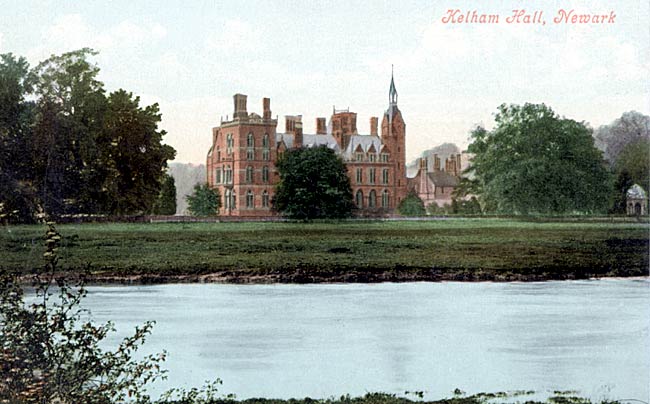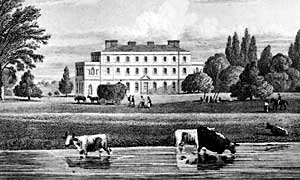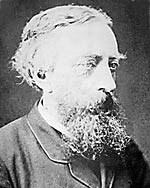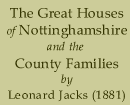< Grove | Contents | Kingston >
Kelham

Kelham Hall from the east bank of the River Trent, c.1910.
ALMOST everyone, who is in the habit of travelling on the Midland line between Nottingham and Newark, has had a glimpse of the noble building known as Kelham Hall, the seat of Mr. Manners-Sutton. As you cross the river Trent by the railway bridge near Newark you see across the fields and amongst the trees, which are not tall enough to conceal its lofty tower and high stack of chimneys, the changing outline of one of the stateliest houses in this part of England. Twenty years ago or more, a fire, the origin of which has never been satisfactorily ascertained, wrecked Kelham Hall, and left its four bare walls standing, charred and grim, amid the same trees which with ampler boughs shelter and protect from eastern blasts, its more magnificent successor. On the 27th of November, 1857, after the servants at the only barely completed mansion had retired to rest, the alarm of fire was given. The owner and his lady were abroad on that date, but their two children—the marriage of the lady who in the account of the disaster is described as a little girl three and a half years of age, was celebrated with great festivity only a few years ago—were in the house at the time. The results of this fearful fire were most disastrous. At the time of its occurrence the house, as I have said, had only just been restored at very great expense, and at the very time Mons. Verreau, the eminent French artist, was on the premises, giving the finishing touch to the costly work with which he had been entrusted. Money would repair the loss sustained by the destruction of the building, but it could not replace the heirlooms which became a prey to the flames. Four valuable historical portraits were consumed ; those of James II., William III., Queen Anne, and Lady Ann Hyde. A number of family portraits which were with difficulty saved from the wreck, hang upon the walls of the present mansion, but these that I have named were damaged beyond redemption. The music room, drawing room, and billiard room were completely swept away. Upstairs valuable furniture, with drapings of damask and point lace, was burnt, and damage to the extent of some £15,000 was done in a very few hours.

Kelham Hall in 1829. This building was built c.1730 by John Sanderson and destroyed by fire in 1857.
Singularly enough, the ancient fabric which stood on this site was destroyed by fire in the reign of William and Mary. Some five years after the burning of the restored mansion there had been created a new Kelham hall of magnificent proportion, and of nil architectural beauty superior to that possessed by its predecessor. It stands there now, a grand ornament to an exquisite landscape. The late Sir Gilbert Scott supplied the designs, and Kelham Hall is said to be one of that great architect’s most successful works. It is built in the Italian style, of red brick with stone facings, and its sumptuous front, seen from the road, suggests many lofty and beautiful rooms. Approaching the hall from Newark you are only made aware of its whereabouts by furtive glimpses of red bricks, for there is much foliage around Kelham. Without possessing elevation, which is generally considered a necessary advantage, Kelham Hall enjoys a most beautiful situation, and nature has given lavish aid to its improvement. It commands a lovely hit of river scenery. Right in front of its windows the Treat flows broad and rapid, making angry little eddies where its course is impeded, and sweeping swiftly through the wide arches of the handsomest bridge in the county. Away to the right the spire of St. Mary Magdalene’s Church at Newark rises sharp and bold against the sky, and all about are the fine tall trees—ash, oak, chestnut, elm, and fir—which thickly stud the twenty-five acres of park land that belong to the Kelham estate. As I walk along the broad, leaf-covered, gravel drive that leads to the house a pair of pheasants, which have come to look for something better than " hedge-fruit," utter their harsh, startling note, and hide themselves in the thick shrubs which skirt either side of the walk. The immediate approach of the house is through a spacious glass-covered court. It ought, perhaps, to be described as a conservatory, for it contains an assemblage of palms and trees of foreign extraction, which flourish with topical luxuriance. It is a magnificent house inside, and the arrangements are in exquisite taste. The ceilings of the several rooms are wonders of beauty. They ought almost to be called roofs, for they are arched and slanting, beautifully mounded and wondrously decorated, the designs showing a delicacy of execution which could only have been achieved by first-rate artists. The Music hall is a superb room, with a floor of polished oak, inlaid with rare woods which have been set with every care and precision. There are pillars of polished granite, arches of stone, mullioned windows, and a spacious fireplace with a kind of slanting canopy supported by granite pillars. In the principal drawing room the ceiling—the ceilings form one of the great charms of Kelham, is even more beautiful than that of the music gallery and the other rooms. It is not a large room, but it is exquisitely furnished with a suite of green velvet. The walls are panelled with the same material, and between the panels are hung some three or four bright modern pictures of large size. The pillar in the centre of the room, to which the painted ceiling dips for support, is very beautiful. It is a triad of time most delicious marble of that rare and richly marked creamy variety, which is so much thought of. The upper part of the pillar has a moulding of metal elaborately wrought. The stonework of the windows of this room shows very fine carving, and the pillars placed at the sides of each one of them are of Australian marble, dark and wavy. The several liquid mirrors with which the room is ornamented add to its brightness.
In another part of the house there is a small drawing-room panelled with cedar, which gives out a delicious odour that never dies away, and here again one is charmed with the ceiling, which shows the blue tint of a summer sky. There is a great profusion of stone carving about the house. It forms the frames of the windows it appears about the pillars, and there is more of it outside. The dining room, the morning room, the billiard room, and the upstairs rooms are all very beautiful, and perpetuate the general idea of beauty with which one is impressed. Such a gigantic work was the re-building of Kelham hall that one or two of the rooms are yet in an unfinished state. One apartment with stained glass windows was intended for a chapel, but it has never been completed and there is yet another unfinished room, and one would think the house was large enough for all requirements if it never was finished. In what is called the morning room there is an exquisite miniature on ivory of Mrs. Manners-Sutton, painted some twenty years ago by an artist who achieved some considerable celebrity in this department of his profession, and on the walls is a portrait in oil of the owner of Kelham, the work of a French painter. There are some half-dozen or more family portraits in this room, including those of Sir William and Lady Hungerford, Lady Lexington, wife of Robert first Lord Lexington, of whom Mr. Manners-Sutton is the lineal descendent. Several much-prized portraits were destroyed by the fire of l857, but others were happily preserved, and Kelham now boasts a good collection of family pictures, the larger of which are hung in interesting array on the ample wall flanking the main staircase. These furnish us with a history of the family. There are here Lord George Manners-Sutton, who achieved a military celebrity; the Hon. William George Sutton, son of the second Lord Lexington ; Bridget, daughter and heiress of the second Baron Lexington, by whose marriage the family became united with the house of Manners (the name borne by the Duke of Rutland); Robert created Baron Lexington, of Averham, in the reign of the first Charles, and Mary, a daughter of the house of St. Leger, who became wife of Lord Lexington. In Mr. Manners-Sutton’s business room there are one or two pictures and a portrait over the mantelpiece of the third Duke of Rutland’s son, John, Marquis of Granby, who, judging from the expression of healthy, and settled contentment that the canvas shows, was well satisfied with his lot.
The table in the room is strewn with letters, papers, and books of reference, for Mr. Manners-Sutton is a thorough man of business, and when at Kelham lie spends much time in his comfortable little business room amongst his books and papers. The principal upstairs rooms at Kelham are superbly fitted, and here again there is some fine ceiling work. From a boudoir upstairs that charming view towards Newark is to be bad in its best aspect. The gardens outside are just what the pleasure grounds of a great house like this should be. They are extensive and tastefully laid out in spacious lawns, ornamental flower beds and trim walks, and in summer, when the flowers are in bloom, they look bright and beautiful. The grey church with its low tower, grassy, silent church yard
Where lies the turf in many a mouldering heap,
and dark yews can be reached through the gardens. Inside there is a monument of fine statutary marble, to the memory of the last Lord Lexington and his lady; outside, in the tower, there was, at the time of my visit, a battered clock, which at a quarter to eight, some time or another, was afflicted with paralysis, and had never "gone since.

John Henry Manners Sutton, 1822-1898.
Mr. Manners-Sutton’s family is of considerable antiquity. his ancestors were the Lords Lexington, who took their title from a village of that name in the north of the county, and one of whom served his country as ambassador to the Court of Turkey. Henry de Lexington, the fourth baron, died in 1257, when the title became extinct. William de Sutton came in for a considerable share of the property of this noble, and his descendant, Robert Sutton, was in 1646 created Baron Lexington of Averham, but at the death of his successor in 1723, the title again became extinct, and has not since been revived. From the year 1792 till his death, in 1805, Charles Manners-Sutton was Archbishop of Canterbury, and his son, who bore the same name, was for many years Speaker of the House of Commons. Mr. John Henry Manners-Sutton has had some political experiences. In the year 1847, when a young man, he was elected Member of Parliament for Newark as a Liberal Conservative. His opponent at that election was Colonel Stuart, Q.C., a London gentleman, who came forward in the Protection interests, Mr. Manners-Sutton being the free-trade candidate. At the nomination which took place in July of the year just given, Mr. John Handley proposed Mr. J. H. Manners-Sutton as a fit and proper person to represent the borough, a nomination which was seconded by Councillor Lacey, and the show of hands was in favour of Mr. Sutton. Mr. Manners-Sutton’s speech on that occasion was both temperate and modest. He admitted the grave charge of youth that had been brought against him, and told the electors that "the only ground on which he could rely for the honour he sought was that of friendship." He was elected by a very appreciable majority, but he did not remain in Parliament to see education extended to all classes of the State—an education such as in these days is provided for the poorest child. Mr. Manners-Sutton is a magistrate for the county and was High Sheriff of Nottinghamshire in 1863.
